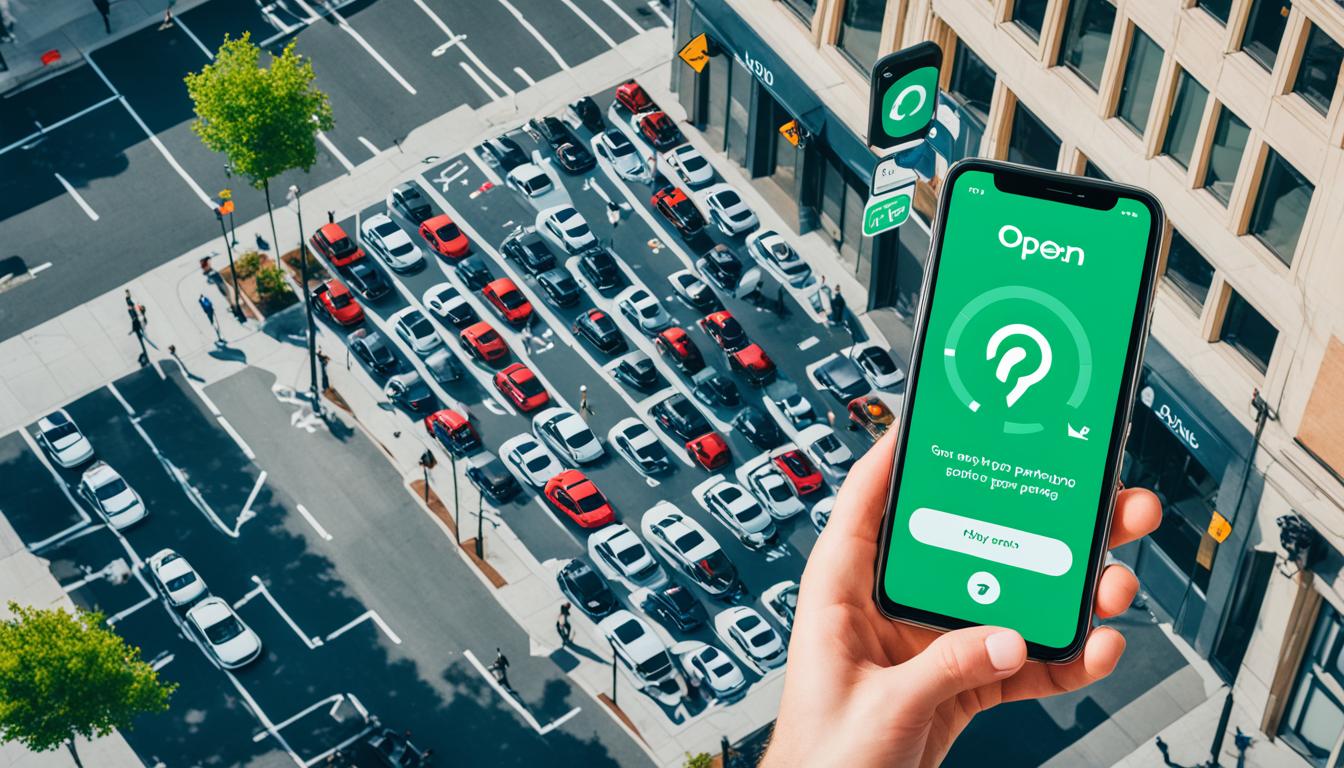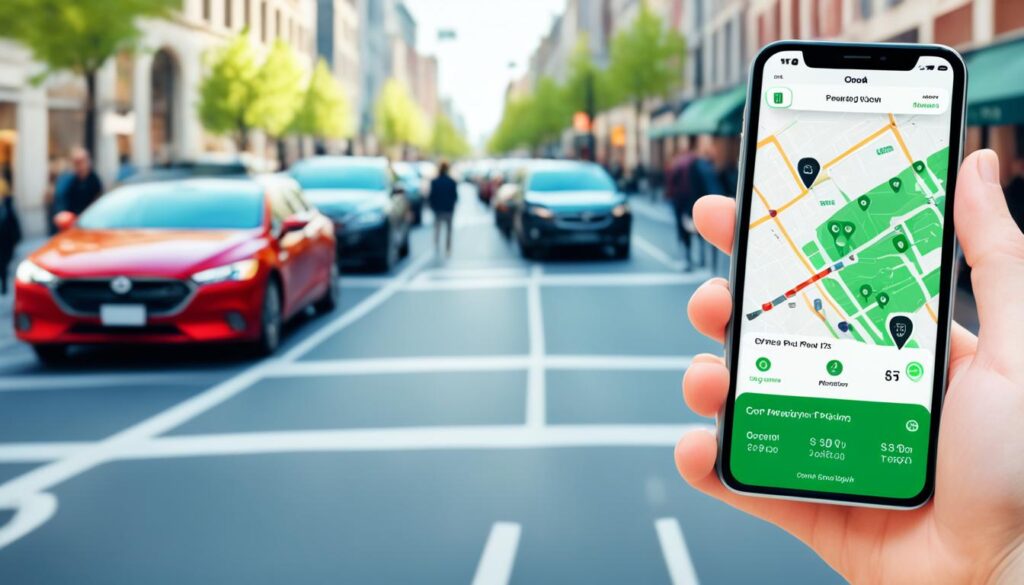Finding a parking spot in busy cities can be hard, leading to frustration and wasted time. But, on-demand parking apps have changed this. They make finding parking easier for city folks.
These apps use technology to improve parking. Users can quickly find, reserve, and pay for spots with their phones. They offer location services, easy reservations, and secure payments.
Data insights are key to these apps. Predictive modeling and machine learning help set the right prices and keep users happy. The article also covers legal rules for these apps.
If you’re into urban planning, starting a mobility startup, or just want to change the parking game, this guide is for you. It shows how to build apps that really help city people.
Table of Contents
Key Takeaways
- On-demand parking solutions apps leverage technology to revolutionize the urban parking experience.
- Integrating location-based services, streamlining the reservation process, and enabling secure payments are crucial features.
- Data analytics and machine learning can optimize pricing strategies and enhance user engagement.
- Addressing regulatory compliance and legal considerations is vital for successful app development and deployment.
- On-demand parking solutions apps have the potential to transform urban mobility and reduce parking-related challenges.
Introduction to On-Demand Parking Solutions
Finding a parking spot in the city can be hard and takes a lot of time. Drivers often circle around, looking for a spot, but there aren’t many. They face the challenge of city parking’s complexities.
The Parking Predicament: Challenges Faced by Urban Dwellers
Urban dwellers face many parking issues every day. There’s not enough parking space, more people, and more cars. This leads to wasted time and fuel, causing traffic jams, pollution, and frustration.
The Rise of On-Demand Parking Apps: A Game-Changer
On-demand parking apps have changed the game. They use GPS and real-time data to make finding parking easy. Now, with just a few taps, drivers can find, reserve, and pay for parking spots easily.
“On-demand parking apps have become a lifesaver for urban dwellers, providing a convenient and stress-free solution to the age-old problem of finding a parking spot.”
These apps are becoming more popular, changing how we park in the city. They make driving easier and help reduce pollution from cars looking for spots. The future of getting around the city looks bright with these new parking solutions.
Understanding the User Experience
Creating a smooth user experience is key for on-demand parking apps. By carefully planning the user’s journey, from finding the app to booking a parking spot, developers can make a platform that meets urban drivers’ needs.
Mapping User Journeys: From Discovery to Reservation
The user experience of on-demand parking apps has many important steps. First, the app must be easy to find, with strong marketing and a good online presence to draw in users. Then, the app should have a simple setup process, letting users quickly learn about the app’s features.
As users use the app, finding and filtering parking spots is key. Good search options, updates on availability, and personalized tips can make finding a parking spot easier. The booking process should be easy, with clear steps, secure payments, and good booking management.
- Discoverability: Ensure the app is easily found through effective marketing and a strong online presence.
- Onboarding: Provide a smooth and intuitive onboarding experience for new users.
- Search and Filtering: Offer robust search and filtering capabilities to help users find the perfect parking spot.
- Reservation Process: Streamline the reservation process, with secure payment integration and efficient booking management.
By carefully planning the user’s journey and focusing on urban drivers’ needs, developers can make a standout app. This approach ensures a great user experience that makes the app stand out in a crowded market.
“The ultimate goal of any on-demand parking app is to make the parking experience seamless and stress-free for users. By understanding their needs and pain points, we can design an app that truly resonates with the target audience.”
Building On-Demand Parking Solutions Apps
Creating effective on-demand parking solutions apps needs a careful plan. It must cover key parts for a smooth user experience. This includes using location services, making the booking easy, and secure payment options. These apps should meet the needs of city people looking for easy parking.
Integrating Location-Based Services
At the heart of these apps is finding parking spots in real-time. They use GPS and geolocation to show where parking is available. This helps users find parking easily and quickly.
Streamlining the Reservation Process
The booking process is key to a good user experience. Developers should make it simple and easy. Users should be able to quickly find, pick, and book a parking spot without trouble.
Enabling Secure Payment Gateways
Having safe and easy payment options is crucial for trust and more users. On-demand parking apps should work with trusted payment gateways. This lets users pay for parking without worry about fraud or other issues.
Leveraging Data Analytics and Machine Learning
Using data analytics and machine learning helps improve these apps. Predictive models can guess parking demand. Data-driven prices can make sure parking spaces are used well.
| Feature | Description |
|---|---|
| GPS and Geolocation | Pinpoint available parking spots in real-time, guiding users to their desired locations. |
| Reservation Process | Offer a smooth and intuitive flow for users to search, select, and book parking spots. |
| Secure Payment Gateways | Integrate reliable payment options to ensure secure and convenient transactions. |
| Data Analytics and Machine Learning | Leverage predictive modeling and data-driven insights to optimize parking utilization and pricing strategies. |
By adding these key features and using the latest tech, on-demand parking apps can change how city folks find parking. They offer a smooth and efficient way to solve parking problems.
Integrating Location-Based Services
In the world of on-demand parking solutions, location-based services are changing the game. They use GPS and geolocation to find parking spots quickly and accurately. This helps users get to their destinations without hassle.
GPS and Geolocation: Pinpointing Parking Spots
GPS and geolocation in parking apps track where parking spots are available. Users can see a live map of their area, showing where parking spots are. This helps drivers find a spot fast, avoiding the stress of driving around.
Real-Time Availability Updates: Keeping Users Informed
These apps also give real-time updates on parking spots. When a spot is taken or left empty, the app knows and tells users. This means users always have the latest info, making parking easier and more convenient.
| Feature | Benefit |
|---|---|
| GPS and Geolocation | Pinpoints available parking spots with precision |
| Real-Time Availability Updates | Keeps users informed of the current parking situation |
On-demand parking apps are changing how drivers find parking in cities. With GPS and real-time updates, these apps make parking easier and smarter. They let users make better choices and improve their parking experience.
Streamlining the Reservation Process
In the world of on-demand parking solutions, making the reservation process smooth is key. It’s what makes the user experience great or not. Having easy-to-use parking spot booking features is a must. This ensures users can quickly find and secure a parking spot without getting frustrated.
Creating a user-friendly interface is a big part of making the reservation process better. On-demand parking apps should be easy to navigate and look good. They should guide users through booking with clear steps. Features like real-time updates, interactive maps, and easy selection options help users find and book the right spot fast.
- Intuitive user interface for a smooth booking experience
- Real-time availability updates to ensure users can find open spots
- Interactive maps to visually navigate and select parking locations
- Seamless reservation process with clear, step-by-step instructions
The on-demand parking app reservation process should focus on speed and ease. Adding features like pre-saved payment methods, one-tap booking, and push notifications for reservations makes booking a spot better. This way, users can book their spot easily and efficiently.
“The key to a successful on-demand parking app is making the reservation process as frictionless as possible for the user.”
By focusing on making the reservation process easy, on-demand parking can change the game. It helps city folks deal with parking easily and confidently.
Enabling Secure Payment Gateways
In the world of on-demand parking solutions, making sure payments are secure is key. Users want a smooth and safe way to pay for their parking spots. By using strong on-demand parking app payment integration and secure payment options, developers can make transactions easy and safe.
Choosing a reliable and easy-to-use payment gateway is important for on-demand parking apps. These gateways should work well with the app and offer many payment ways. This includes credit/debit cards, mobile wallets, and digital payments. The app should have a wide range of secure payment options.
Building trust with users means using strong security measures. This means using end-to-end encryption, keeping data safe, and following rules like PCI-DSS. By focusing on keeping financial transactions safe, developers can make users trust the app more. This leads to more people using the app and being happier with it.
| Payment Method | Advantages | Considerations |
|---|---|---|
| Credit/Debit Card | Widely accepted, familiar to users | Requires integration with payment gateway, potential for fraud |
| Mobile Wallets | Convenient, secure, and growing in popularity | Requires mobile device support, integration with digital wallets |
| Digital Payment Platforms | Offer diverse payment options, efficient transaction processing | Requires integration with third-party platforms, potential fees |
By thinking about payment and security in on-demand parking apps, developers can make a great user experience. This leads to more people using the app and being happy with it.
“Secure and convenient payment options are essential for the success of any on-demand parking app. Users want to feel confident that their financial information is safe and that the transaction process is streamlined.”
Building On-Demand Parking Solutions Apps
Creating effective on-demand parking solutions apps means knowing what users need and following the latest trends. These apps have key features that help both customers and parking space owners. They make parking easier and more efficient.
One important part of a successful parking app is using location-based services. This lets users find parking spots quickly and easily. With GPS and geolocation, users get real-time updates on parking availability. This helps them plan their trips and book spots ahead of time.
Making the booking process easy is also key. Apps should have simple navigation, clear booking options, and a secure way to pay. This makes parking smooth and encourages users to come back and leave good reviews.
Adding data analytics and machine learning can make parking apps even better. These tools help predict parking demand and adjust prices and space use. By using data, developers can meet the changing needs of users and parking owners.
“The future of urban mobility lies in the seamless integration of on-demand parking solutions with smart city initiatives and emerging transportation technologies.”
The need for easy and accessible parking is growing. So, making parking apps that are full of features and focus on users is crucial. By using new tech and focusing on what users and parking owners need, developers can change the parking experience for the better.
Leveraging Data Analytics and Machine Learning
The on-demand parking solutions industry is growing fast. Data analytics and machine learning are key to making things better for users and businesses. These technologies help solve big challenges like predictive parking demand modeling and dynamic pricing strategies.
Predictive Modeling: Forecasting Parking Demand
App developers use parking app data analytics to make predictive models. These models look at lots of data, like past use, weather, events, and traffic. They predict when parking will be busy or not.
This lets parking solutions manage their spots better. They make sure there are enough spaces for everyone at all times.
Optimizing Pricing Strategies with Data-Driven Insights
Data analytics is also key for dynamic pricing for parking apps. By looking at how users act, how full the spots are, and the market, developers can set the right prices. This way, they make users happy and make more money.
| Metric | Impact on Pricing |
|---|---|
| Occupancy Rates | Higher occupancy rates may warrant higher prices to manage demand |
| User Preferences | Analyzing user willingness to pay can inform optimal pricing points |
| Market Competition | Monitoring competitor pricing helps maintain a competitive edge |
By using parking app data analytics, predictive modeling, and dynamic pricing, parking solutions can make things smoother for users. They also make their businesses run better and more profitably.
Enhancing User Engagement
In the world of on-demand parking solutions, keeping users engaged is crucial. Using push notifications is a key strategy for app developers. These alerts help keep users interested and make parking more positive.
Push Notifications: Keeping Users in the Loop
Push notifications are essential for on-demand parking apps. They keep users updated on parking spots, reservation changes, and more. This feature helps developers keep users engaged and retain them.
Creating effective push notifications is important. They should be timely, informative, and tailored to each user. Alerts about parking spots, reservation confirmations, and reminders about expiring sessions make for a smoother experience.
| Push Notification Type | Objective |
|---|---|
| Parking Availability | Notify users of open parking spots in their vicinity |
| Reservation Updates | Inform users of changes to their parking reservations |
| Expiring Sessions | Remind users to extend or end their parking sessions |
By using push notifications wisely, on-demand parking app developers can build a loyal user base. This leads to more repeat usage and higher user engagement levels.
“Effective push notifications can be the difference between a user who simply downloads your app and one who becomes a dedicated, long-term customer.”
Addressing Regulatory Compliance and Legal Considerations
As more people use on-demand parking apps, developers face many rules and legal issues. On-demand parking app regulatory compliance and legal issues are key to making these apps work well and last. They ensure the apps are safe and trusted by users.
One big worry is data privacy. These apps gather a lot of info from users, like where they are, personal details, and how they pay. It’s crucial to follow rules like the GDPR in Europe or the CCPA in the U.S. to keep user info safe and avoid legal trouble.
Also, user safety is very important. Developers must make sure their apps follow local parking laws, like time limits and fees. Not following these rules can lead to legal problems and hurt the app’s reputation.
- Following local parking laws
- Following data privacy laws
- Keeping users safe and secure
By tackling these legal and regulatory issues early, developers can create apps that are easy to use and follow the law. This careful planning reduces legal risks, builds trust with users, and helps these new parking solutions become more popular.
“The key to successful on-demand parking app development lies in striking a balance between innovation and compliance.”
Monetization Strategies for On-Demand Parking Apps
On-demand parking solutions apps are getting more popular. Developers need to find new ways to make money to keep their apps going and profitable. They are looking at subscription-based parking plans and making money through ads and partnerships.
Subscription Models: Offering Flexible Parking Plans
Many on-demand parking apps now offer subscription models. These give users different parking plans to choose from. Options include:
- Discounted hourly or daily rates for frequent users
- Monthly or annual plans that offer unlimited or discounted parking in designated lots or garages
- Premium packages that grant users priority access to the most coveted parking spots
This way, app developers can meet the needs of different people, from those who park occasionally to daily commuters. It also helps them make a steady income.
Advertising and Partnerships: Exploring Revenue Streams
On-demand parking apps can also make money through ads and partnerships. Some ways to do this include:
- In-app advertising: Showing ads from local businesses, parking providers, or other relevant partners
- Sponsored parking spots: Letting parking lot owners or garages promote their places in the app
- Referral programs: Working with other services, like rideshare or car rental companies, and sharing the profits
By using different ways to make money, on-demand parking app developers can have a strong and lasting business. This helps both the users and the app’s profits.
The future of on-demand parking is about combining these new ways to make money. This lets app developers offer a great service to users. It also helps them grow and make more money over time.
Integrating with Smart City Initiatives
As cities grow, on-demand parking apps and parking solutions in smart cities are key. They help make cities more connected and advanced. These solutions make parking easy for everyone, helping cities meet their smart city goals.
Smart cities use tech and data to tackle issues like traffic, pollution, and waste. Adding on-demand parking apps to these efforts makes parking better and more efficient. This leads to cities that are nicer to live in and more sustainable.
Real-time data and analytics are crucial for better parking. On-demand parking apps give insights on parking needs. This helps city planners make smart choices about parking, traffic, and pricing. It means less traffic, cleaner air, and happier people.
Also, on-demand parking apps work well with other smart city tech. They connect with systems like smart transport and IoT devices. This creates a better, more connected city experience for everyone.
“The integration of on-demand parking solutions with smart city initiatives is a crucial step towards building more livable, sustainable, and technologically advanced urban environments.”
As cities get smarter, on-demand parking apps and parking solutions in smart cities will matter more. They use tech and data to improve transport, cut down on pollution, and make cities better for everyone.
Future Trends and Innovations
The on-demand parking solutions industry is changing fast. New trends and innovations are making the future exciting. Connected vehicles and autonomous parking are leading the way. So are sustainable and eco-friendly parking solutions.
Connected Vehicles and Autonomous Parking
Connected vehicles and autonomous parking are changing how we find parking spots. With more connected cars, on-demand parking apps can use real-time data for a smoother experience. Drivers can relax while their cars find and reserve spots.
Sustainability and Green Parking Solutions
There’s a big push for sustainable and eco-friendly parking now. On-demand parking apps are adding features like discounts for electric vehicles and carpooling. They’re also working with public transport. This helps reduce traffic, emissions, and makes cities greener.
As on-demand parking apps evolve, they need to focus on these trends. By using connected vehicles, autonomous parking, and green solutions, they can offer a better, eco-friendly experience. This puts them at the forefront of the changing industry.
| Trend | Description | Impact |
|---|---|---|
| Connected Vehicles and Autonomous Parking | Integration of connected vehicle technology and autonomous parking features in on-demand parking apps. | Improved parking experience, reduced congestion, and more efficient utilization of parking resources. |
| Sustainability and Green Parking Solutions | Incorporation of eco-friendly features in on-demand parking apps, such as discounts for electric vehicles, carpooling incentives, and integration with public transportation. | Reduced environmental impact, lower emissions, and a more sustainable urban landscape. |
Conclusion
This guide has covered how to make on-demand parking solutions apps successful. It talked about the problems city folks face, using location services, making booking easy, and using data to improve things. This way, app makers can offer solutions that fit what drivers need today.
As the demand for on-demand parking grows, keeping up with new trends and being eco-friendly is key. This will help these apps succeed over time.
By using the tips from this article, app developers can make their parking apps essential for city life and smart city planning. The guide’s summary and key points are great for developers wanting to offer easy and efficient parking options.
The world is getting more digital, and cities are facing parking issues. So, the need for new parking solutions will keep growing. By staying updated with technology and trends, app developers can lead the change in the parking industry. This will help make cities better and more sustainable.














